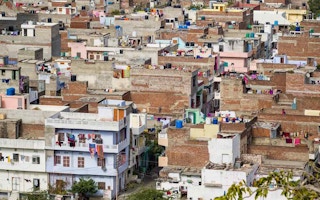The Himalayas, and the rivers that flow out of them, are a gift of the collision of the south Asian land mass into the Asian continent. As a result, the Himalayan region is also beset by a third “gift”: earthquakes.
The earthquake that hit Nepal on 25 April 2015, accounting for thousands of deaths, reinforced the link between the mountains and earthquakes, but the other linkage – between earthquakes and rivers – is less well understood. This linkage, though, is most prominent in the city of New Delhi, the capital of India.
A city built along, and upon, a river
Although situated some distance from the Himalayas, the buildings of Delhi sway with each new earthquake, as they did when a tremor hit the Afghanistan-Tajikistan border on 10 April 2016. These quakes come as a warning to the nearly 20 million people that live in Delhi, but they do not register the real threat that Delhi faces – and that is the combination of a river and an earthquake.
Delhi has been, historically, the city by the river Yamuna. The river has supplied the city with its water, and been a venue for navigation. But it was not merely a river by the city, KT Ravindran, former dean of the Department of Urban Design at the School of Planning and Architecture, New Delhi, told thethirdpole.net.
“The waters of the Yamuna ran through the city, along its waterways and many marshy areas,” he said. “If you look at the old buildings, from the era of the Delhi Sultanate and the Mughal period such as the Red Fort, these were all on rocky outcroppings, which allowed the state to defend itself from the river and those trying to sneak in over the marshes.”
The hidden threat of liquefaction
Over time these marshy areas have been built over, and buildings have come up as Delhi expanded from a city of just over 3.6 million in 1951, when the first census was done, to just under 17 million people in 2011 (at the time of the last census). Under these new structures, though, remains the soil that the Yamuna brought down with it from the mountains and along its journey, creating a layer of sandy, loose soil upon which the city is now built.
Although hidden from view, this sandy soil makes Delhi a very dangerous city to live in, because of a process called “liquefaction”. This process occurs when a very strong earthquake hits sandy soil, and under the impact of the shock, the sandy soil behaves like a thick liquid rather than a solid, leading to the collapse of buildings. The 1975 Tangshan earthquake in China showcased this phenomenon.
Considered one of the most devastating earthquakes in history, it caused the death of anywhere between 242,000 to 655,000 people. The primary problem was that, due to liquefaction, “the quake either destroyed or severely damaged more than 85% of unreinforced houses, multistorey buildings, and other structures in Tangshan.”
Government studies identified most vulnerable areas
In November 2006, when the first India Disaster Management Congresswas held, some of the papers presented identified exactly how large a threat this was. One presentation by C Ghosh, of the National Institute of Disaster Management, along with P Mishra, AK Shukla (from the India Meteorological Department) and Kishor Kumar (from the Geotechnical Engineering division of the Central Road Research Institute), captured the scale of the problem.
After their experiments and investigations, they found that, “about 80% of the soil cover in Delhi are of liquefying type (ML, CL-ML) and Yamuna river belt area is having high potential for liquefaction induced damages.”
In March 2014, working on these findings, the Centre for Seismology at the India Meteorological Department presented a paper titled, “A report on Seismic Hazard Microzonation of NCT Delhi”. In the paper, the scientists looked at the probability of liquefaction in case of an earthquake.
The resulting map, showing the liquefaction potential at a depth of 0-9 metres below ground level, paints a large part of Delhi, especially the area around the Yamuna, red, indicating that these areas are sure to undergo that process.
Along the rivers, the buildings continue to go up
Over the last few years, especially after every new earthquake, prominent Indian media services lead with stories about the many millions that could die. They also carry articles indicating how to “earthquake-proof” your house. Very few of them pay any attention to precisely the areas that are most at risk – those next to the Yamuna, where many of thenewest, most expensive houses are coming up, all on land that, when the big earthquake hits Delhi, will turn to jelly.
Nor is Delhi the only city in South Asia under threat by this phenomenon. According to a World Bank study, while Chittagong and Sylhet in Bangladesh lie in the most earthquake prone areas, it is Dhaka, which lies in less earthquake prone area, which may be in more danger.
Two thirds of Dhaka is built on landfill, making it very susceptible to liquefaction. Karachi, in Pakistan, is somewhat safer, as a large part of the city is built on the hilly areas, and its seismic history is uncertain. Nevertheless some areas along the coast are prone to liquefaction too.
All the great cities of South Asia suffer a huge influx of people coming to live there, find prosperity and employment. In response buildings continue to come up in unsafe areas, or those not properly assessed. Earthquakes seem far away, and a home by the river seems like a good investment, until the buildings start to shake.










